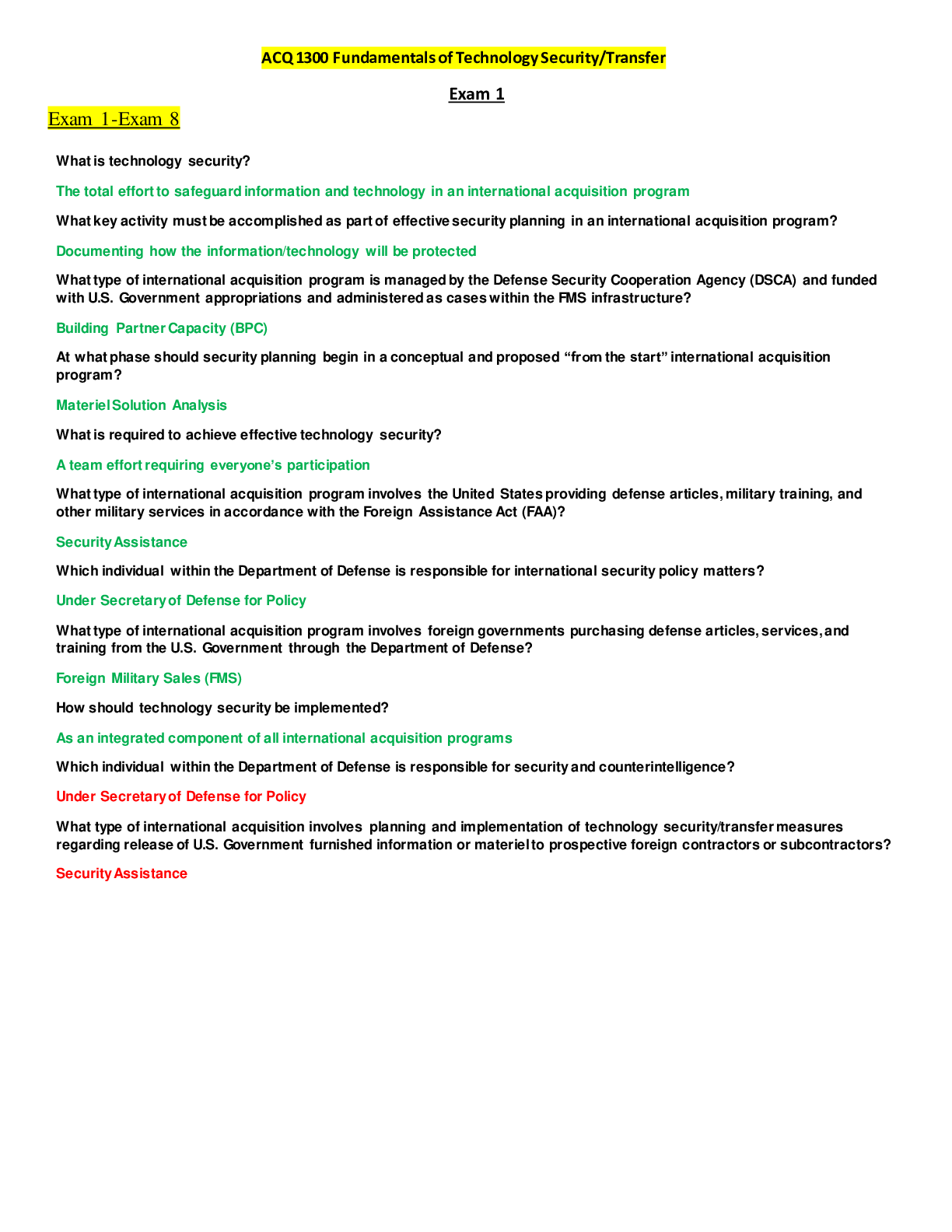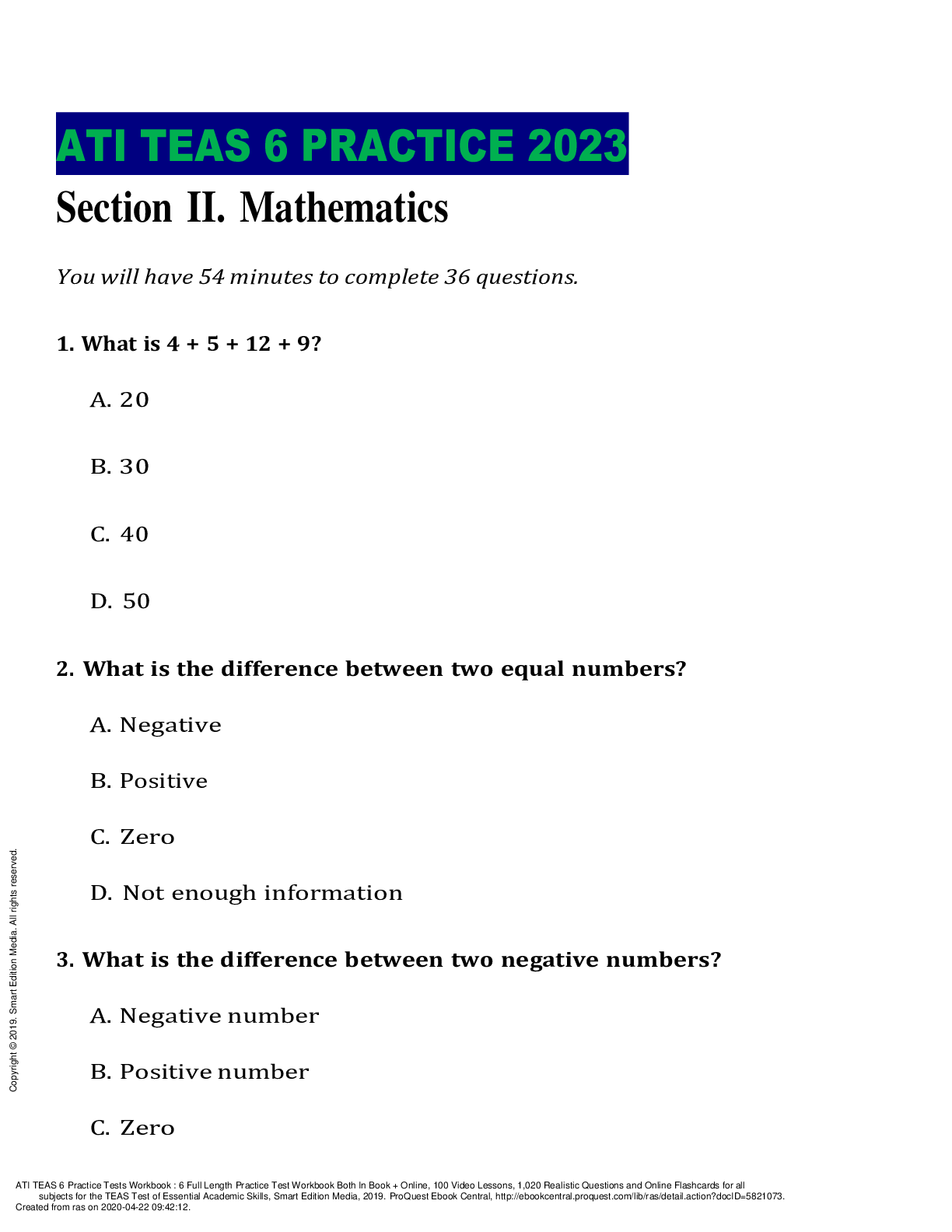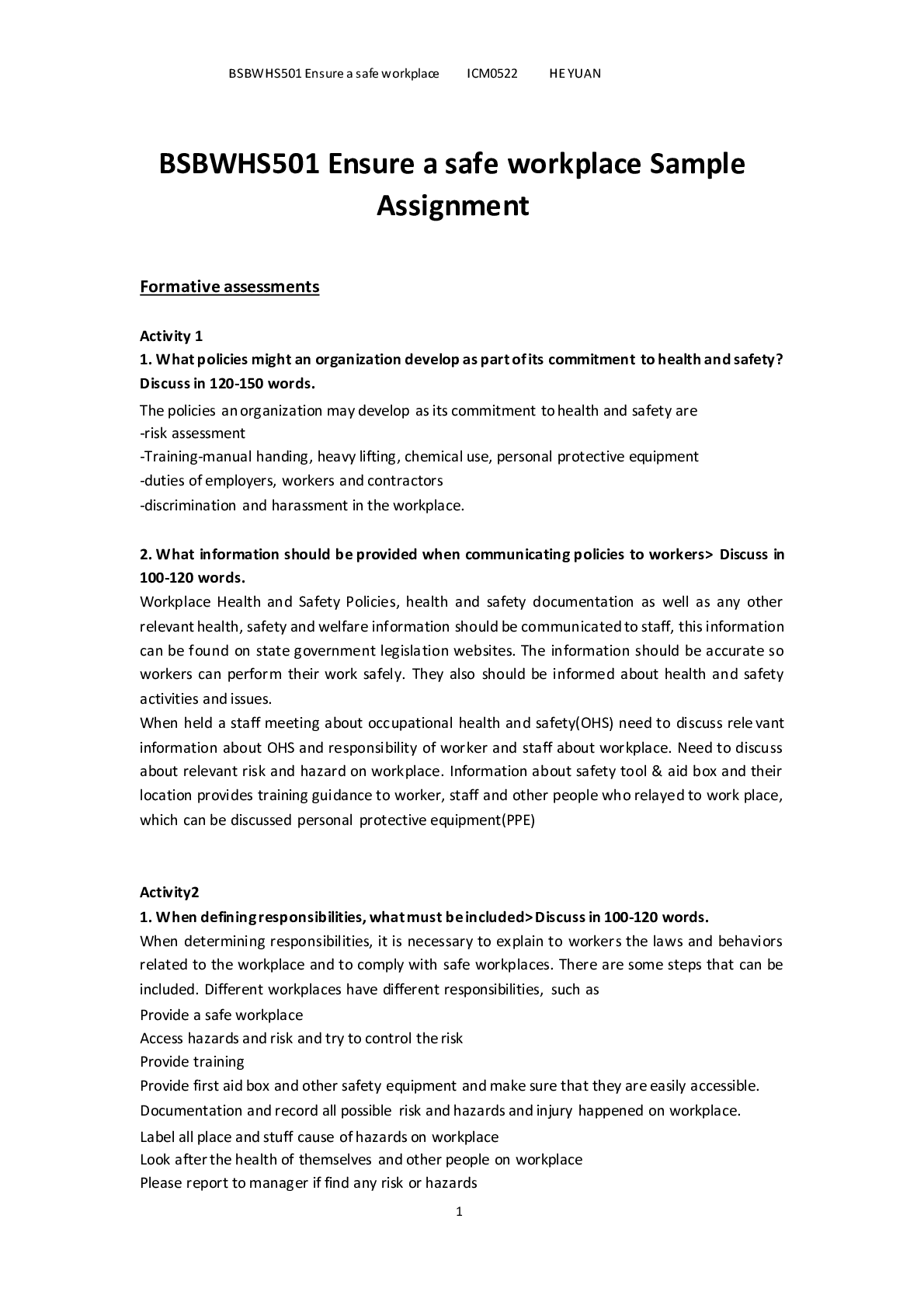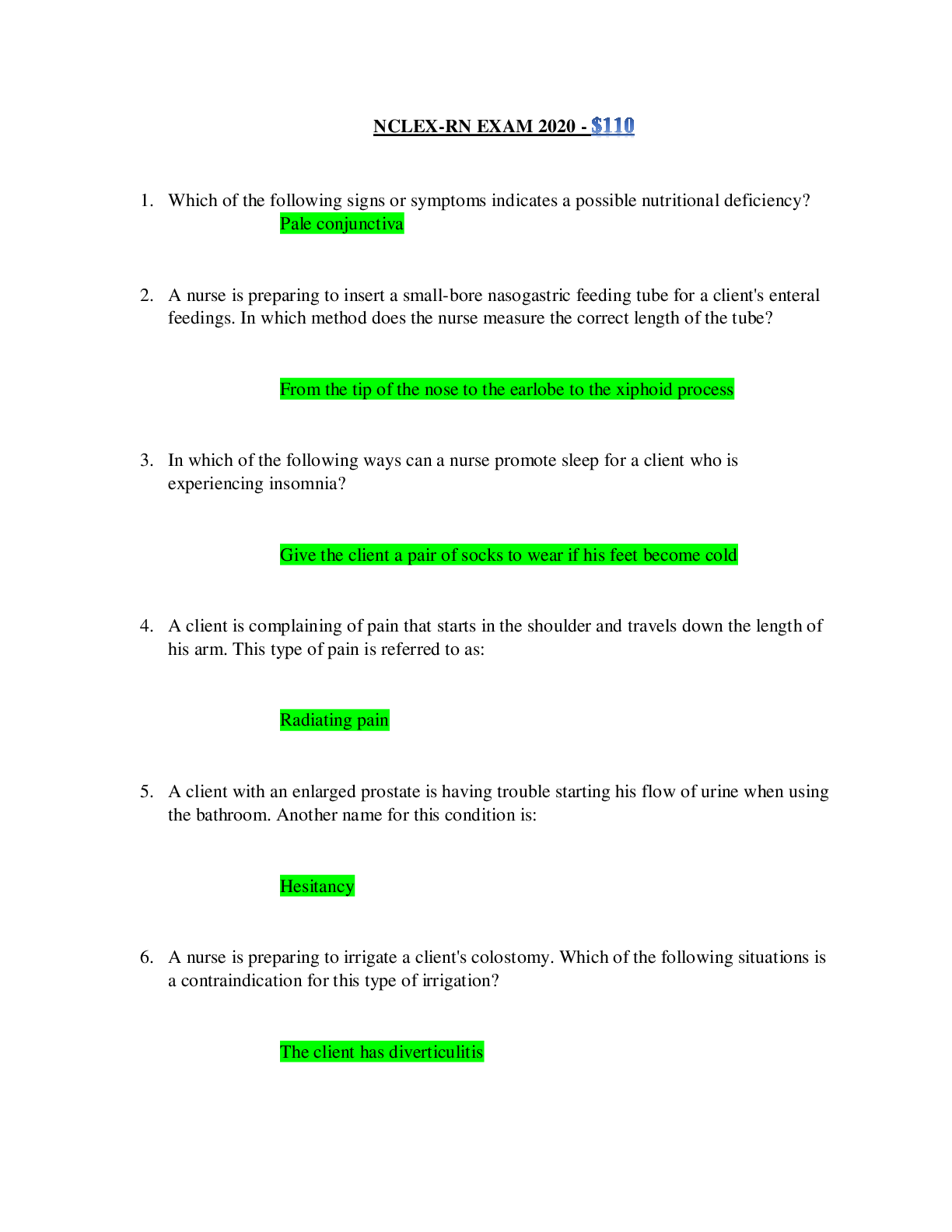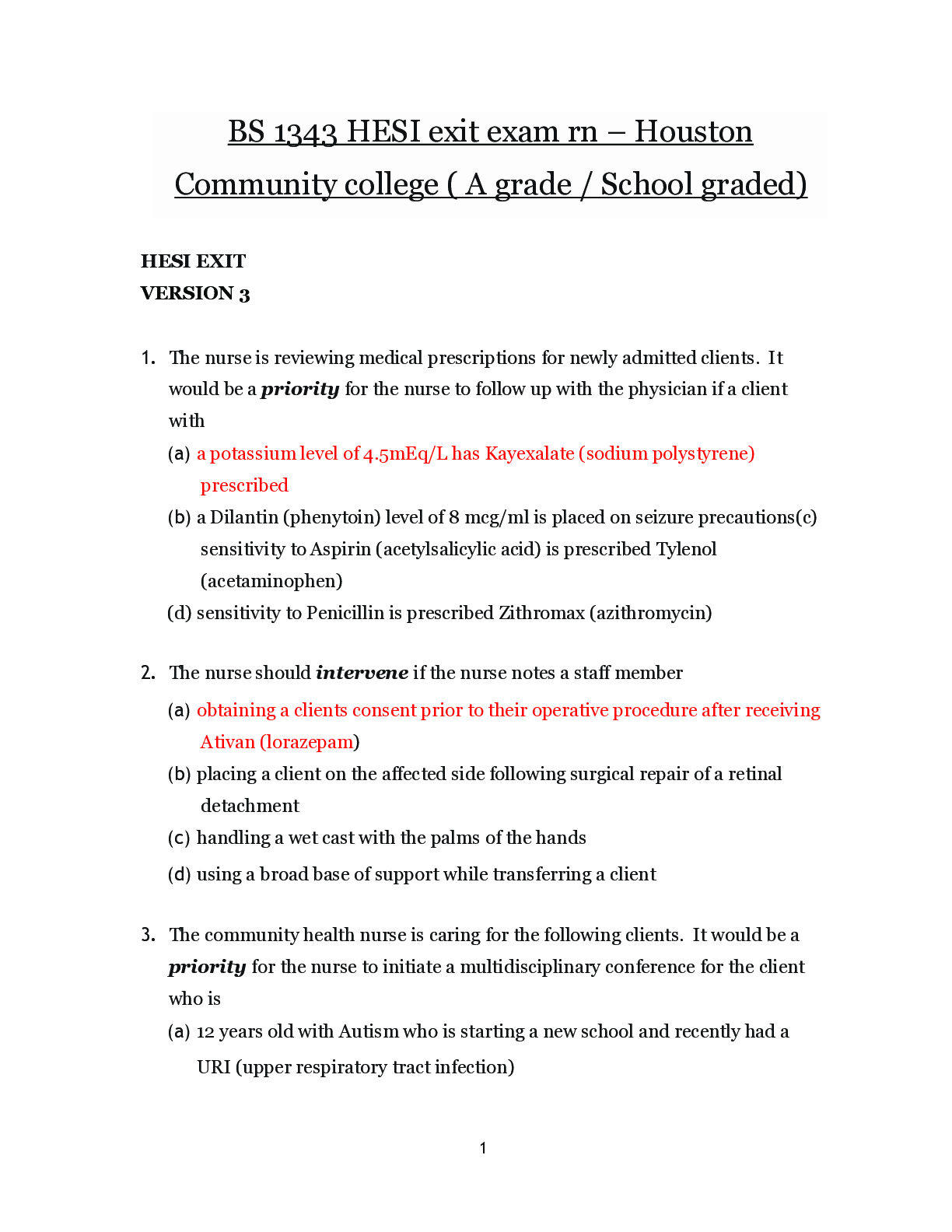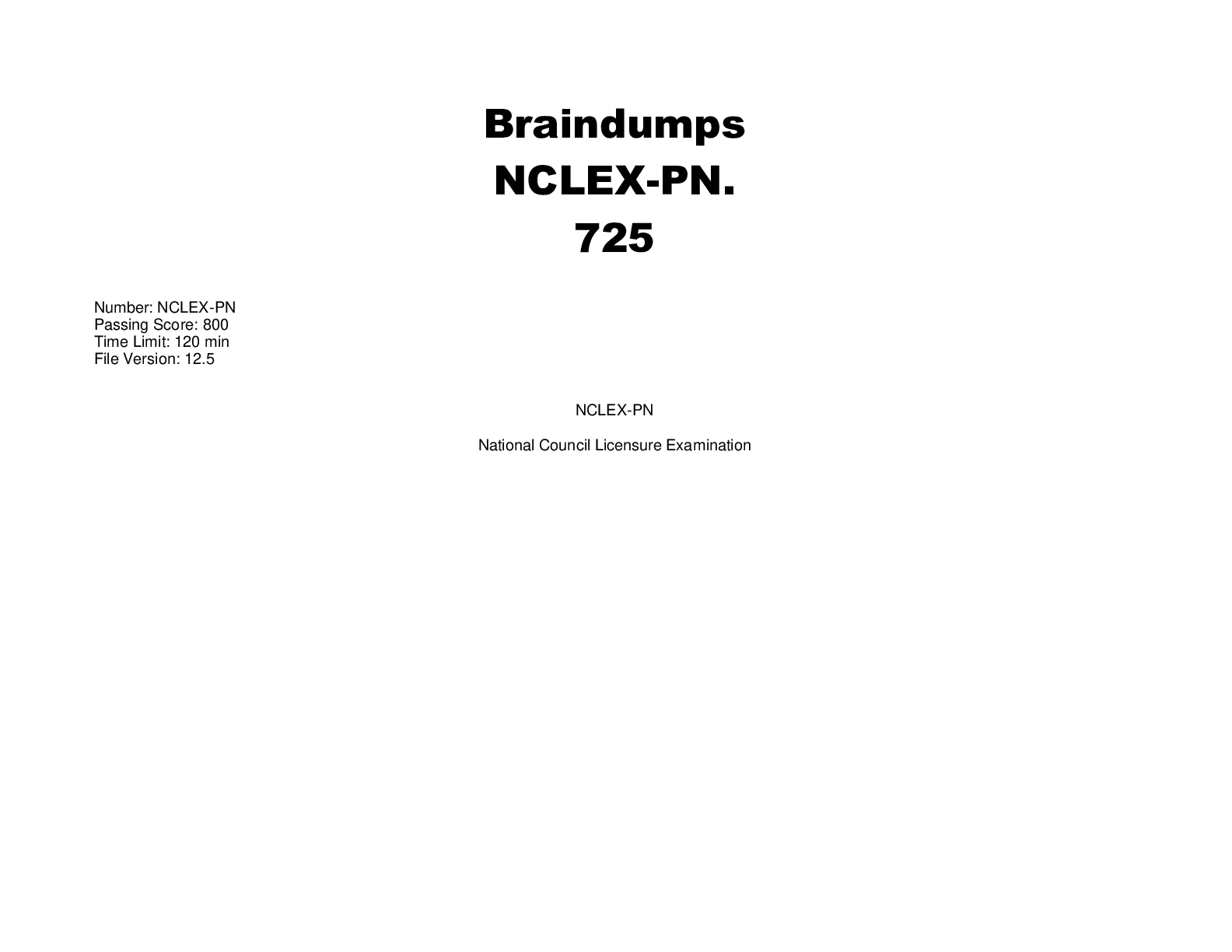Medicine Year 1, Summer Exams 2021-2022 Manchester University
Document Content and Description Below
Medicine Year 1, Summer Exams 2021-2022 Manchester University What are the clinical signs of asthma? {{Ans- Obstructive Broncho-constriction & Mucus hypersecretion Recurrent and episodic wheez... es, Use of accessory muscles to breath, Fast breathing/heart rate chest tightness short of breath hyper responsive airway First line treatment of heart failure (ABAL) {{Ans- ACE inhibitor - rampipril up to 10mg (avoid in valve disease) (can use ARB such as candestartan) Beta Blocker - bisoprolol up to 10mg Alodosterone antagonist - spironolactone Loop Diuretics - Furosemide Monitor U & E's What features does a lower motor neurone cause? {{Ans- hypotonia hyporeflexia muscle wasting fasiculations What is the resting potential of a neuron? threshold potential? {{Ans- -65mV -55mV Where is the juxtaglomerular apparatus located? {{Ans- Between the afferent arteriole and the distal convoluted tubule. What is the cause of the absolute refractory period? {{Ans- Insufficient sodium channels available for activation The refractory period follows membrane depolarisation during an action potential. First is the absolute refractory period, where the are too few sodium channels available for activation, no matter the depolarisation stimulus. Potassium channels may be open and the membrane may be hyperpolarised but these are not the cause of the refractory period. The relative refractory period describes the state where an action potential requires a larger depolarisation stimulus than normal. What do A-beta fibers do? {{Ans- Non-painful touch & innervate muscles A-Beta fibers overrides painful A-Delta C-fibers, therefore overriding the pain. What do A-delta fibres do? {{Ans- A-delta are general sensory fibres that can transmit both innocuous and noxious stimuli - they are small and myelinated. What do C fibres detect? {{Ans- dull pain What proteins make up gap junctions? {{Ans- connexins What makes up adherens junctions? {{Ans- Adherens junctions contains plaque, a dense layer of proteins on the inside of the plasma membrane that attaches both to membrane proteins and to microfilaments of the cytoskeleton. What are cadherins? {{Ans- glycoproteins, calcium dependent adhesion proteins that help muscle and epithelial cells stay bound together. They are transmembrane proteins that bind within the cytoplasm to intermediate filaments like keratin. Extracellularly, bind to other cadherins forming desomosomes and adherens junctions. *All interactions are calcium dependent, thus removing calcium will cause dissociated of cadherin mediated junctions = loss of cell adhesion*. What are the 3 parts of troponin? {{Ans- Troponin C, I and T. Troponin C binds to calcium; it is linked to troponin I, which binds to actin, and troponin T that is bound to tropomyosin. The binding of calcium to Trop C causes movement in troponin I and T, which results in movement of tropomyosin out of the myosin binding-sites on actin. What protein on the sarcoplasmic reticulum mediates calcium release in response to dihydropyridine activation? {{Ans- ryanodine What process allows formation of cross bridges? {{Ans- movement of tropomyosin on actin What is the consequence of phosphate group loss from myosin in skeletal muscle contraction {{Ans- movement of myosin head What is the difference between type I and II skeletal muscle fibres? {{Ans- Type I fibres generate low contraction force, use aerobic metabolism (utilising glycogen), are very fatigue resistant and comprise the postural musculature. Type II fibres are anaerobic, with high contraction force but fatigue quickly; they have myoglobin stored to use when oxygen falls very low. What are satellite cells? {{Ans- stem cells which give rise to myoblasts What is the difference between neuromuscular junction and other types of synapse? {{Ans- The neuromuscular junction (NMJ) is like a specialised electrical synapse with a motor end-plate on the myofibres. The end-plate generates an end-plate potential (EPP) when acetylcholine (ACh) binds nicotinic receptors. The EPP is a large excitatory post-synaptic potential (EPSP), which has a high chance of stimulating an action potential. The EPP decays, like other EPSP. ACh acts like other transmitters: released by calcium, diffuses across the cleft and is re-uptaken. What ligand-receptor combination mediates sympathetic neurone vasoconstriction of peripheral arterioles? {{Ans- Noradrenaline - alpha-1-adrenoreceptor Post-ganglionic sympathetic neurones release noradrenaline from secretory vesicles. This acts on alpha-1-adrenoreceptors on vascular smooth muscle to increase intracellular calcium. Acetylcholine binds nicotinic receptors at the pre- to post-ganglionic sympathetic neurone synapse. Adrenaline shows preference for beta-adrenoreceptors. Adrenaline acts at beta-adrenoreceptors to cause vasodilatation in the coronary vessels. What is the stimulus for release of adrenaline from the adrenal medulla? {{Ans- acetylcholine at nicotynic receptors What is the autonomic innervation of sweat glands? {{Ans- Sympathetic acetylcholine released Sweat glands, unlike salivary and lacrimal glands, are supplied by sympathetic neurones. The post-ganglionic sympathetic neurones are unique because they release acetylcholine that acts at nicotinic receptors, to increase sweat production Which of the following cranial nerves have a parasympathetic component? {{Ans- there are 4 cranial nerves with parasympathetic action. Occulomotor (III) supplies constrictor pupillae. Facial (VII) nerve supplies submandibular and sublingual salivary glands plus the lacrimal glands. Glossopharyngeal (IX) supplies parotid gland. Vagus (X) supplies many internal viscera. What is neuropraxia? {{Ans- Compression of a neurone Which cells form the blood brain barrier? {{Ans- astrocytes Which nerve supplies the skin on the posterior of the lower leg? {{Ans- tibial nerve How does the ventilation-perfusion ratio change across a normal lung? {{Ans- The base has the lowest ventilation perfusion ratio There is a ventilation-perfusion gradient across the normal lung. The base receives much more perfusion than the apex due to the effects of gravity. It also receives more ventilation than the apex due to tethering forces but relatively the base has more perfusion than ventilation (a low V:Q ratio). Conversely the apex has a high V:Q as it receives relatively more ventilation than perfusion. Over the whole lung has a V:Q of 0.8. A V:Q of zero is always abnormal and suggests no ventilation. A V:Q of 1 may happen in a few areas around the mid-zone of the lung. What is the effect of a local decrease in ventilation:perfusion ratio? {{Ans- Bronchodilatation and vasoconstriction A local decrease in V:Q met by an attempt to correct it by the pulmonary vasculature an airways. To raise the ventilation there is bronchodilatation and to reduce the perfusion there is vasoconstriction, the net effect is to increase V:Q. This becomes a problem in patients who have chronically reduced V:Q across the whole lung (e.g. COPD), which results in pulmonary vasoconstriction, raise pulmonary artery pressures and ultimately right heart failure (cor pulmonale). The ratio between which two measurable factors determines arterial pH? {{Ans- HCO3- and paCO2 In a chronic respiratory acidosis what will be found on blood gas analysis? {{Ans- Low pH, high CO2, high HCO3- Respiratory acidosis occurs when inadequate ventilation results in retention of CO2, which causes the acidosis. The response of the kidneys is to reabsorb and generate HCO3- to compensate for the acidosis, therefore HCO3- also rises. Renal compensation takes 2-3 days to occur, so HCO3- may not be high in an acute respiratory acidosis. "A" is a partially compensated metabolic alkalosis. "B" is a compensated respiratory alkalosis. "D" would be a complicated mixed picture. "E" is a compensated metabolic acidosis. Where is the origin for the neurones that activate inspiration? {{Ans- medulla Inspiration is caused by activation of the phrenic nerve, which begins in the medullary inspiratory centres (dorsal and ventral). There is also a pontine inspiratory centre but this is most involved in the timing of respiration. The Botzinger complex is another area in the medulla involved in inspiration, however its main role is initiating the medullary areas to trigger inspiration. What is the brainstem output following a fall in CSF pH? {{Ans- Increased action potential frequency on the phrenic nerve CSF pH is the most important factor in determining ventilation. A rise in serum CO2 results in a fall in CSF pH. CO2 diffuses across the blood brain barrier and forms H+ and HCO3- in the CSF. Chemoreceptors respond to levels of H+, but they are specific to respiratory acidosis and do not respond to metabolic acidosis. In order to correct the raised CO2 ventilation must be increased, this occurs by raising the frequency of action potentials on the phrenic nerve. The carotid body is the site of peripheral chemoreceptors. The nucleus ambiguus is the origin of the vagus. What is the most important stimulus in controlling alveolar ventilation? {{Ans- pH of CSF What mediates hyperventilation in metabolic acidosis? {{Ans- Low pH - at carotid bodies In metabolic acidosis there is a gain of H+ or loss of HCO3- through a mechanism separate to respiratory CO2, for example acidic ketones in diabetic ketoacidosis. The reduced pH is sensed at the carotid bodies - the carotid sinus detects changes in blood pressure. Low CO2 would be either from a respiratory alkalosis or respiratory compensation for a metabolic acidosis. What is the key pathological feature of... Asthma COPD Pulmonary fibrosis Emphysema {{Ans- Asthma is characterised by intermittent, reversible bronchoconstriction that can occur due to a variety of stimuli. Chronic, poorly controlled asthma may result in some degree of smooth muscle hyperplasia and increased mucus but these are more commonly associated with COPD; small airway collapse is also seen in COPD. Connective tissue is deposited in pulmonary fibrosis. Emphysema causes loss of alveolar surface area. chronic bronchitis - smooth muscle hyperplasia & mucus Which part of the rib most likely to fracture? {{Ans- the angle On a chest x-ray, what pathology does 'blunting of costo-phrenic angles' suggest? {{Ans- pleural efflusion Following chronic smoke exposure respiratory epithelium may undergo metaplasia to which epithelium type? {{Ans- Pseudostrafitifed CCE to Stratified squamous What nerve passes through diaphragm at T10? {{Ans- right vagus List the structures anterior to posterior in pulmonary hila {{Ans- From anterior to posterior lies: pulmonary veins, pulmonary arteries, bronchi. The bronchial arteries are the vessels that supply oxygenated blood to the conducting airways, they are small vessels and lie within the hila. Lymphatic vessels and lymph nodes also lie within the hila. Which blood vessel is most commonly implicated in posterior epistaxis? {{Ans- The sphenopalatine artery is a large artery that runs on the posterior wall of the nasopharynx to supply parts of the nasal septum, it is joined by the posterior ethmoidal artery and then anastamoses in Little's area. Posterior epistaxis (nosebleeds) is that where the site of bleeding cannot be seen on nasoscopy. It can be severe and require blood transfusions. Which law describes the inversely proportional relationship between the volume and pressure of a closed system? {{Ans- Boyles law [Show More]
Last updated: 2 years ago
Preview 1 out of 187 pages
.png)
Buy this document to get the full access instantly
Instant Download Access after purchase
Buy NowInstant download
We Accept:

Reviews( 0 )
$8.00
Can't find what you want? Try our AI powered Search
Document information
Connected school, study & course
About the document
Uploaded On
Jun 08, 2022
Number of pages
187
Written in
Additional information
This document has been written for:
Uploaded
Jun 08, 2022
Downloads
0
Views
74

